FEAR AND DYSTOPIA VIA MODERNISM AND TECHNOLOGY:
page 1: The Black Cat ▪ Alphaville
▪ page 2: ▪ True Stories ▪ A Clockwork Orange ▪ Brazil
The mock-umentary True Stories (Byrne 1986) is set in fictional Virgil, Texas. The name is invented, but the setting is a very average small town and suburbs in the American southwest, architecturally familiar and unremarkable. Like the style of Alphaville, the environment is not manipulated to create strangeness but shot to convey the strangeness of the real world: Byrne’s artistic intention is to illustrate some of the absurdities of the stereotypical American Dream, in an entirely typical environment. The film does not aim to create feelings of fear but presents a caricature of small-town America as a possible dystopia, questioning what is accepted as normal.
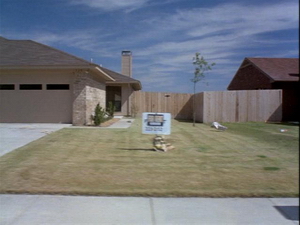 The urban environment of the film is very bland, with mass-produced warehouses and cookie-cutter suburban houses behind enormous garages. The factory is presented as an enigmatic box, giving no indication of what happens inside. The architecture of the town centre is slightly more varied but no more interesting: the artistic intention is to create a visual parody of what the audience has seen a hundred times before.
The urban environment of the film is very bland, with mass-produced warehouses and cookie-cutter suburban houses behind enormous garages. The factory is presented as an enigmatic box, giving no indication of what happens inside. The architecture of the town centre is slightly more varied but no more interesting: the artistic intention is to create a visual parody of what the audience has seen a hundred times before.
The environment around Virgil is flat and featureless, a vast undeveloped emptiness which shows how isolated the town is. Even the mall, the social and cultural centre of Virgil, is a faceless building in a field of 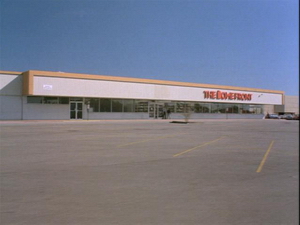 parking. The monotonous architecture makes the plot much more poignant: within the isolated environment of this generic town, steeped in materialist culture, the characters search for a sense of ‘special-ness’. The impression of a benign dystopia comes from this irony, as well as from the general boredom which emanates from the architecture.
parking. The monotonous architecture makes the plot much more poignant: within the isolated environment of this generic town, steeped in materialist culture, the characters search for a sense of ‘special-ness’. The impression of a benign dystopia comes from this irony, as well as from the general boredom which emanates from the architecture.
The urban environment of True Stories creates a feeling of emptiness, even in town. Byrne uses a similar technique as Godard uses in Alphaville: an urban environment presented without enough detail or variety becomes tedious then unsettling, even vaguely inhuman. Manipulating this effect, both films use real built environments to create dystopias out of everyday places. Through this use of real environments, both directors give the audience a disconcerting sensation that the dystopia presented may also be real: the present state of the urban environment is not so distant from Virgil, or from ‘futuristic’ Alphaville.
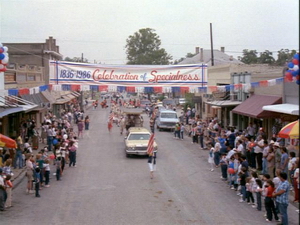 True Stories manages to generate a mild dystopia from the dialectic between an average urban environment and the unusual characters of the film. This is enhanced by the exception to Virgil’s insipid streetscapes, offices and factory: domestic interiors are eclectic and eccentric, some completely overloaded with expressions of personal character. The interior environments indicate citizens’ reactions to the dull sameness of their town,striving for uniqueness inside their houses as an antidote to the uniformity outside.
True Stories manages to generate a mild dystopia from the dialectic between an average urban environment and the unusual characters of the film. This is enhanced by the exception to Virgil’s insipid streetscapes, offices and factory: domestic interiors are eclectic and eccentric, some completely overloaded with expressions of personal character. The interior environments indicate citizens’ reactions to the dull sameness of their town,striving for uniqueness inside their houses as an antidote to the uniformity outside.
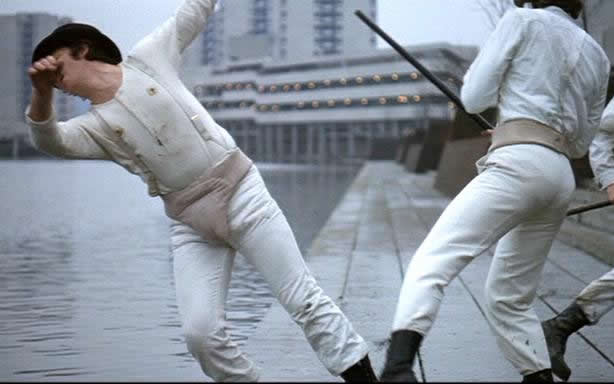 A Clockwork Orange (Kubrick 1972) is less about the environment than the characters of the film, but the same effect is used to some extent: the setting is in modern quarters of a real city, grey and bleak, contrasted with wild pop-art interiors. The architecture of protagonist Alex’s part of town is not monotonous but mundane, conveying the uncaring coldness of expanses of concrete to mirror the cruel actions of the plot.
A Clockwork Orange (Kubrick 1972) is less about the environment than the characters of the film, but the same effect is used to some extent: the setting is in modern quarters of a real city, grey and bleak, contrasted with wild pop-art interiors. The architecture of protagonist Alex’s part of town is not monotonous but mundane, conveying the uncaring coldness of expanses of concrete to mirror the cruel actions of the plot.
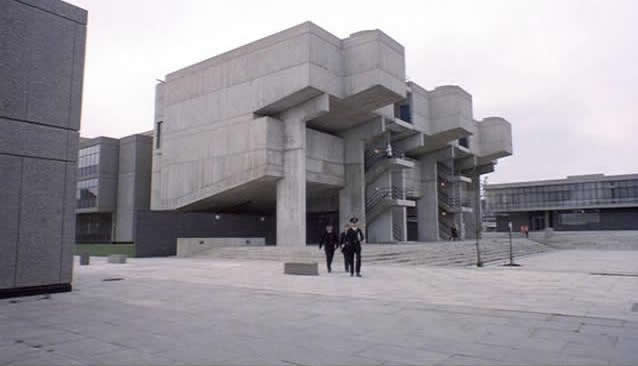 The exterior of Alex’s building echoes the exterior of the Ludovico Institute, a harsh concrete landscape of brutalist buildings in an empty court. The effect is like the underground city of Metropolis 1927 (to be discussed below): the sets suggest that the people there are somehow less than human.
The exterior of Alex’s building echoes the exterior of the Ludovico Institute, a harsh concrete landscape of brutalist buildings in an empty court. The effect is like the underground city of Metropolis 1927 (to be discussed below): the sets suggest that the people there are somehow less than human.
In A Clockwork Orange dystopia is presented more as a personal than as a social state, but the effects are still disturbing.Some stereotypical places of fear – dark, run-down parts of the city and empty rural areas – are used (as in Caligari and Sin City) but unsettling events also occur under the bright lights of modern houses (as in The Black Cat). The urban environment sets the mood, but it is the characters and the plot which ultimately create the fear and dystopia in the film.
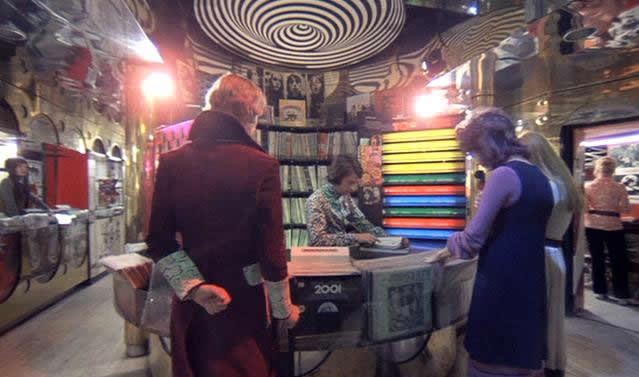 The colorful and perverse pop-art interiors in Alex’s domain give the film a bizarre and disconcerting design, but the sets themselves do not create any great fear or feeling of dystopia, merely an impression of deviant taste. Indeed, the sets were probably perceived as less remarkable at the time of the film’s release than they are now.
The colorful and perverse pop-art interiors in Alex’s domain give the film a bizarre and disconcerting design, but the sets themselves do not create any great fear or feeling of dystopia, merely an impression of deviant taste. Indeed, the sets were probably perceived as less remarkable at the time of the film’s release than they are now. 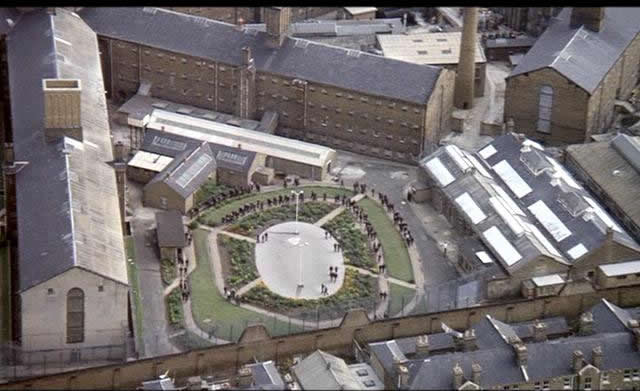 Sets from outside the ‘world’ of Alex’s hoodlum gang - such as the police station and the prison - look very ordinary and bland. Architecture serves to illustrate where Alex is in his element – in control of the plot, if only in his active imagination - and where he is outside his element, when the plot controls him.
Sets from outside the ‘world’ of Alex’s hoodlum gang - such as the police station and the prison - look very ordinary and bland. Architecture serves to illustrate where Alex is in his element – in control of the plot, if only in his active imagination - and where he is outside his element, when the plot controls him.
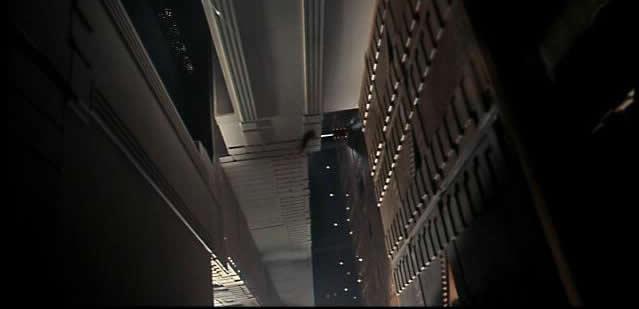 “None of Gilliam’s films do a better job critiquing the modern world than his 1985 sci-fi "tragicomedy" Brazil — the centerpiece of all his films.”
“None of Gilliam’s films do a better job critiquing the modern world than his 1985 sci-fi "tragicomedy" Brazil — the centerpiece of all his films.”
- professor of film studies Keith James Hamel, 2006
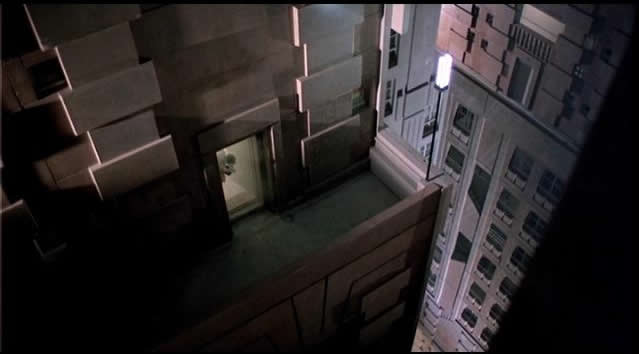 Brazil (Gilliam 1985) takes a different approach, using artificial sets to exaggerate the urban environment beyond familiarity but not beyond recognition. The setting is an imaginary city ‘Somewhere in the 20th Century’ (Gilliam 2005) but this lack of specificity suggests that it could be anywhere, and could be now. The architecture presented is not futuristic but simply bizarre, an overstated satire of the contemporary city.
Brazil (Gilliam 1985) takes a different approach, using artificial sets to exaggerate the urban environment beyond familiarity but not beyond recognition. The setting is an imaginary city ‘Somewhere in the 20th Century’ (Gilliam 2005) but this lack of specificity suggests that it could be anywhere, and could be now. The architecture presented is not futuristic but simply bizarre, an overstated satire of the contemporary city.
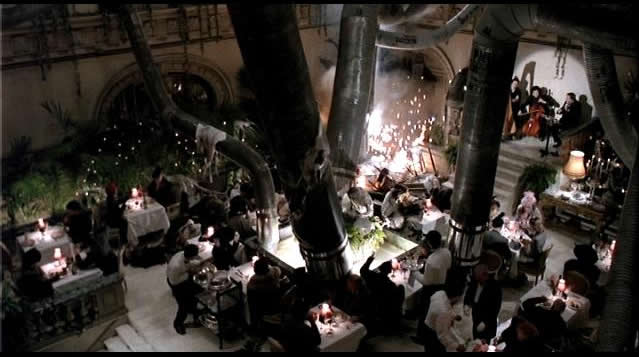 Blank walls without windows often tower out of proportion over protagonist Sam Lowry in hallways, in the street, even in his own office. Enormous ductwork snakes through the otherwise refined neoclassical architecture of a fine restaurant; indeed, oversized ducts seem to emerge everywhere. Domestic interiors are cramped and cluttered, some even sordid. Any architectural style is subdued by the vast scale of the buildings, which become monotonous because of their huge mass – walls of identical window openings often fill the screen.
Blank walls without windows often tower out of proportion over protagonist Sam Lowry in hallways, in the street, even in his own office. Enormous ductwork snakes through the otherwise refined neoclassical architecture of a fine restaurant; indeed, oversized ducts seem to emerge everywhere. Domestic interiors are cramped and cluttered, some even sordid. Any architectural style is subdued by the vast scale of the buildings, which become monotonous because of their huge mass – walls of identical window openings often fill the screen.
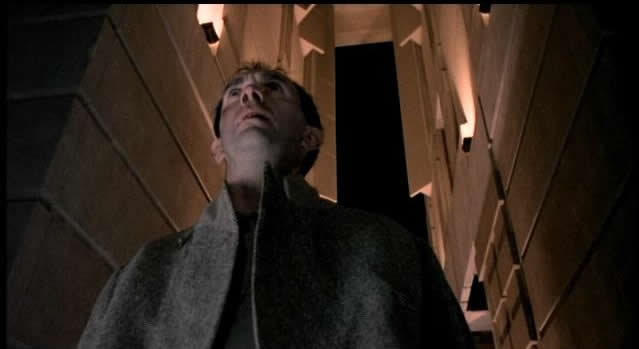 "Immediately obvious in any Gilliam work is how different his films appear from the 'normal' perception of life. When the theater lights go down, the viewer is thrust into a world that is unsettling and unfamiliar."
"Immediately obvious in any Gilliam work is how different his films appear from the 'normal' perception of life. When the theater lights go down, the viewer is thrust into a world that is unsettling and unfamiliar."
– professor of film studies Keith James Hamel, 2006
Brazil makes the world look strange and uncomfortable by altering the scale of the urban environment and exaggerating its features, not so much as to become wholly unbelievable (like Caligari) but to simultaneously create the anxiety of an uncomfortable environment and the uneasy feeling that this might all be real. Consequentially, if the environment could be real – as in True Stories and Alphaville – then the story could be real, a social dystopia under rampant and unreasonable government control.














